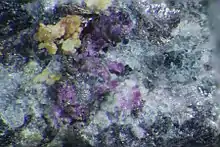Putnisite
Putnisite is a mineral composed of strontium, calcium, chromium, sulfur, carbon, oxygen and hydrogen.[3] It was discovered on the Polar Bear Peninsula in Shire of Dundas, Western Australia in 2007 during mining activity.[3][4] Following identification and recognition by the IMA in 2012[4] the mineral was named after mineralogists Andrew and Christine Putnis.[2]
| Putnisite | |
|---|---|
 Putnisite, from Polar Bear Peninsula, Western Australia, Australia | |
| General | |
| Category | Mineral |
| Formula (repeating unit) | SrCa4Cr83+(CO3)8(SO4)(OH)16·25 H2O |
| Crystal system | Orthorhombic |
| Crystal class | Dipyramidal (mmm) H-M symbol: (2/m 2/m 2/m) |
| Space group | Pnma |
| Unit cell | a = 15.351 Å, b = 20.421 Å, c = 18.270 Å; Z = 4 |
| Identification | |
| Color | Purple |
| Crystal habit | Pseudocubic crystals |
| Cleavage | [100], [010] and [001] good |
| Fracture | Brittle - uneven |
| Mohs scale hardness | 1.5-2 |
| Luster | Vitreous |
| Streak | Pink |
| Diaphaneity | Translucent |
| Specific gravity | 2.20 |
| Optical properties | Biaxial (–) |
| Refractive index | nα = 1.552, nβ = 1.583 and nγ = 1.599 |
| Pleochroism | Distinct: X pale bluish grey, Y pale purple, Z pale purple |
| References | [1][2][3][4] |
Putnisite has unique chemical and structural properties, and does not appear to be related to any of the existing mineralogical families.[2] Crystals are translucent purple, but show distinct pleochroism (from pale purple to pale bluish grey,[3] depending on the angle of observation) and leave pink streaks when rubbed on a flat surface.[3]
Putnisite occurs as small (< 0.5 mm) cube-like crystals in volcanic rock.[2] The mineral formed during the oxidation environment within komatiite to dioritic bodies containing sulfide minerals.[3]
References
- Mineralienatlas
- "New Mineral Shows Nature's Infinite Variability". University of Adelaide. Retrieved 26 April 2014.
- "Putnisite". Mineralogical Magazine. Retrieved 26 April 2014.
- "Putnisite: Putnisite mineral information and data". Mindat.org. 2014-04-07. Retrieved 2014-04-29.